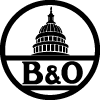
Back سكة حديد بلتيمور وأوهايو Arabic Baltimore and Ohio Railroad Danish Baltimore and Ohio Railroad German Baltimore and Ohio Railroad French Baltimore and Ohio Railroad Hungarian ボルチモア・アンド・オハイオ鉄道 Japanese Baltimore and Ohio Railroad Dutch Baltimore and Ohio Railroad Polish Baltimore and Ohio Railroad Russian Baltimore and Ohio Railroad Swedish
 | |
 All rail lines operated by the B&O and subsidiaries | |
| Overview | |
|---|---|
| Headquarters | B&O Railroad Headquarters Building, 2 North Charles Street, Baltimore, Maryland 1906–1987 |
| Reporting mark | BO |
| Locale | |
| Dates of operation | 1830–1987 |
| Successor | Chessie System/Chesapeake & Ohio Railway/CSX Transportation |
| Technical | |
| Track gauge | 4 ft 8+1⁄2 in (1,435 mm) |
This article needs additional citations for verification. (November 2023) |

The Baltimore and Ohio Railroad (reporting mark BO) was the first common carrier railroad and the oldest railroad in the United States. It operated as B&O from 1830 until 1987, when it was merged into the Chessie System; its lines are today controlled by CSX Transportation.
The railroad was founded to serve merchants from Baltimore who wanted to do business with settlers crossing the Appalachian Mountains. It would compete with several existing and proposed turnpikes and canals, including the Erie and Chesapeake and Ohio Canal. Building west from the port of Baltimore, the B&O reached Sandy Hook, Maryland, in 1834; Cumberland in 1842; the Ohio River at Moundsville, Virginia, in 1852; Wheeling, West Virginia in 1853, and in 1857, Parkersburg, Virginia, below rapids that made navigation difficult during parts of the year.
The railroad, whose owners were Union sympathizers, proved crucial to the North's success during the American Civil War, which caused considerable damage to the system. After the Civil War, the B&O consolidated several feeder lines in Virginia and West Virginia, and expanded westward into Ohio, Indiana, and Illinois.
At the end of 1970, the B&O operated 5,552 miles of road and 10,449 miles of track, not including the Staten Island Rapid Transit (SIRT) or the Reading Railroad and its subsidiaries. After a series of mergers, the B&O became part of the CSX Transportation (CSX) network in 1980.
The B&O is noted for its pioneering innovations in railroading. It was the first U.S. railroad to operate a steam locomotive, it built historic infrastructure, and it operated prestigious passenger trains. It gained additional fame by lending its name as one of the four railroads in the original version of the popular board game Monopoly.